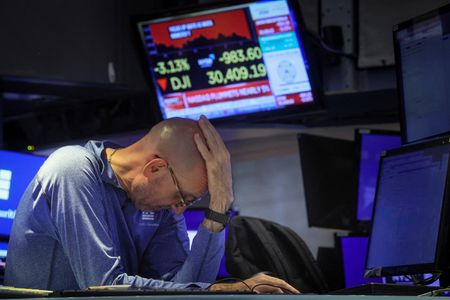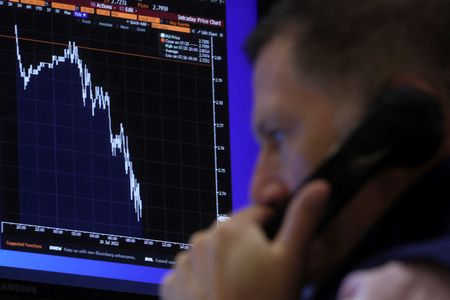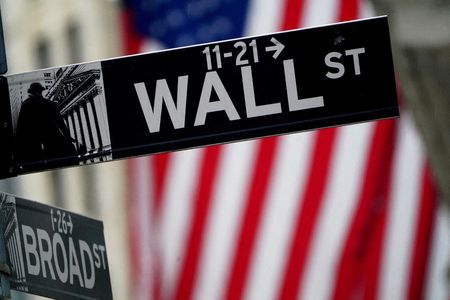By Alden Bentley
(Reuters) – War. Inflation. Polarization. Appalling headlines ricochet around the internet, stocks are skidding, wealth is eroding and the mood on Wall Street has rarely been gloomier.
While some opportunists thrive in adversity, experts say that for many investors it takes a toll on mental health.
Relatively new fields in psychology and economics examine investor behavior, herd mentality, panic, mania and hidden biases that affect decision making – often in ways that negatively affect portfolio performance. Nobel prizes have been awarded to several behavioral finance pioneers in recent decades.
The medical profession has distinguished specialists too. John Schott MD, a portfolio manager at The Colony Group, retired psychiatrist and a recognized expert on market psychology, coined the term Bear Market Depressive Syndrome (BMDS) in his 1998 book “Mind Over Money.”
In a 2009 American Psychoanalyst article, Schott listed BMDS symptoms as sadness, sleep disturbance, decreased concentration, irritability, guilt, discouragement, gastrointestinal problems and/or headaches.
Who has not experienced some of those during times of intense stress?
To keep traders’ heads screwed on straight, some prominent hedge funds have retained in-house psychiatrists and performance coaches, of the type popularized by the Wendy Rhoades character on the Showtime TV series “Billions.”
Schott told Reuters the work of Nobel laureate Vernon Smith demonstrated that market bubbles are primarily due to psychological factors, not financial ones. After prolonged bull markets, investors tend to go into denial during bear markets.
“Part of that, from a psychological standpoint, is defense against depression,” said Schott, who practiced psychoanalysis for 38 years.
“Why did I buy it? Why didn’t I sell it? There is a lot of self blaming rather than accepting the markets go up and down,” he said.
MARKET RISK FACTORS ALMOST UNPRECEDENTED
The S&P 500 was down more than 27% year-to-date in mid-October. Even with a bounce over the past seven trading days it is still down 21% this year and has not been this low since it was emerging from the COVID-19 pandemic panic two years ago. The ghastly downswing contrasts the bull market euphoria a year ago as the benchmark index was advancing to a record high, reached in January.
For younger investors who have not experienced prolonged downturns, the bull-market, buy-the-dip strategy of the past decade no longer works. They can experience a sort of cognitive dissonance, Schott said.
The number of risk factors to process these days is almost unprecedented in the post-World War II era: Russia’s war on Ukraine, the worst inflation in memory, interest rates going up, economies slowing down, fear of another war over Taiwan, U.S. midterm elections and former U.S. President Donald Trump’s continued divisive presence.
A weekly survey by the American Association of Individual Investors shows the ratio of the number of bulls to bears at -33.8% ranks as among the most negative in the survey’s 35-year history.
Goldman Sachs said its Sentiment Indicator in the last week of September posted its 31st consecutive negative reading, a stretch surpassed only by 32 straight weeks of negative readings ending in March 2016.
Jim Paulsen, chief investment strategist at the Leuthold Group, in Minneapolis, noted that the “blue mood” goes beyond Wall Street, with consumer confidence at a post-war low and sentiment down among small businesses and in the C-suite.
“I don’t remember any other time when so many CEOs warned of an imminent recession before actually being in one. Media stories help feed this fear frenzy. It’s not their fault;
there is just so much good material,” he wrote in a recent note.
Call it “information overload,” with news amplified 24/7 on social media. Seema Shah, chief global strategist at Principal Asset Management termed it the “echo chamber of negativity.”
“One of the things now, relative to previous downturns, is the prevalence of social media, where you have that dispersion of news flow, negativity and opinions coming through very, very quickly,” she told Reuters. “That essentially moves the market at a faster pace than you would have seen in previous periods of market weakness.”
But, as they say: “It is darkest just before dawn.” Negative sentiment readings indicate the market is running out of sellers, and are thus considered a bullish signal.
“Bear markets don’t generally end with good news. They end when the news is hopeless, and when it just feels like there is just no chance of this thing recovering soon,” Paulsen said.
(Reporting by Alden Bentley; Editing by Josie Kao)



